India Namkeen Market Size 2025-2029
The India namkeen market size is valued to increase by USD 4.52 billion, at a CAGR of 10.2% from 2024 to 2029. Rising retail space in Tier-II and Tier-III cities of India will drive the India namkeen market.
Major Market Trends & Insights
- By Type - Indian and ethnic snacks segment was valued at USD 5.08 billion in 2022
- By Distribution Channel - Offline segment accounted for the largest market revenue share in 2022
Market Size & Forecast
- Market Opportunities: USD 57.01 million
- Market Future Opportunities: USD 4517.80 million
- CAGR from 2024 to 2029 : 10.2%
Market Summary
- The market represents a significant opportunity for businesses, underpinned by the expanding consumer base and the increasing popularity of packaged snacks. This market's growth is driven by various factors, including the rising disposable income, urbanization, and changing consumer preferences. Online retailing has emerged as a key trend, with e-commerce platforms offering a wider range of choices and convenience to consumers. The availability of substitute products, such as local snacks and street food, has intensified competition. However, traditional retailers are adapting by expanding their product offerings and exploring new distribution channels. The Namkeen Market's future direction lies in innovation and differentiation.
- Companies are focusing on product development, packaging, and branding to cater to evolving consumer tastes. Additionally, the integration of technology, such as automation and contactless delivery, is streamlining operations and enhancing customer experience. In conclusion, the market is witnessing dynamic changes, driven by consumer preferences, urbanization, and the rise of online retailing. Companies must innovate and differentiate to stay competitive in this evolving landscape.
What will be the Size of the India Namkeen Market during the forecast period?
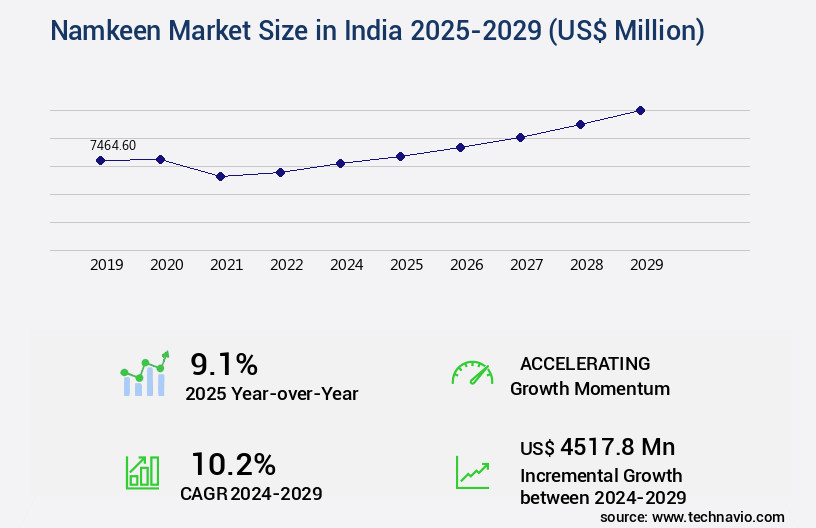
Get Key Insights on Market Forecast (PDF) Request Free Sample
How is the Namkeen in India Market Segmented and what are the key trends of market segmentation?
The namkeen in India industry research report provides comprehensive data (region-wise segment analysis), with forecasts and estimates in "USD million" for the period 2025-2029, as well as historical data from 2019-2023 for the following segments.
- Type
- Indian and ethnic snacks
- Western snacks
- Distribution Channel
- Price Range
- Economy
- Mid-range
- Premium
- Product Type
- Geography
By Type Insights
The indian and ethnic snacks segment is estimated to witness significant growth during the forecast period.
The market is a dynamic and evolving landscape, teeming with a diverse range of traditional and ethnic snacks. Companies like Prataap Snacks Ltd. And Bikaji have commercialized the production of common namkeen varieties, such as farsaan, chiwda, sev, neyappam, bhujia, and mathri, which have been a staple in Indian households for generations. With over 1,300 distinct types of Indian snacks currently available, the market caters to a multitude of consumer preferences, encompassing a vast array of flavors, shapes, sizes, textures, scents, bases, and fillings. India also exports approximately 300 different kinds of ethnic savory foods worldwide. In this competitive market, businesses employ various strategies to stay ahead, including innovative product development, pricing strategies, and brand positioning.
Companies focus on profit margin improvement through ingredient cost analysis, texture modification techniques, and water usage optimization. Sustainable packaging and nutritional labeling requirements are increasingly important, as is sales forecasting based on marketing campaign effectiveness and customer satisfaction metrics. Retail display strategies, consumer segmentation, and production process efficiency are also crucial factors. Food safety regulations, product differentiation, process automation technologies, and market share dynamics further shape the market.
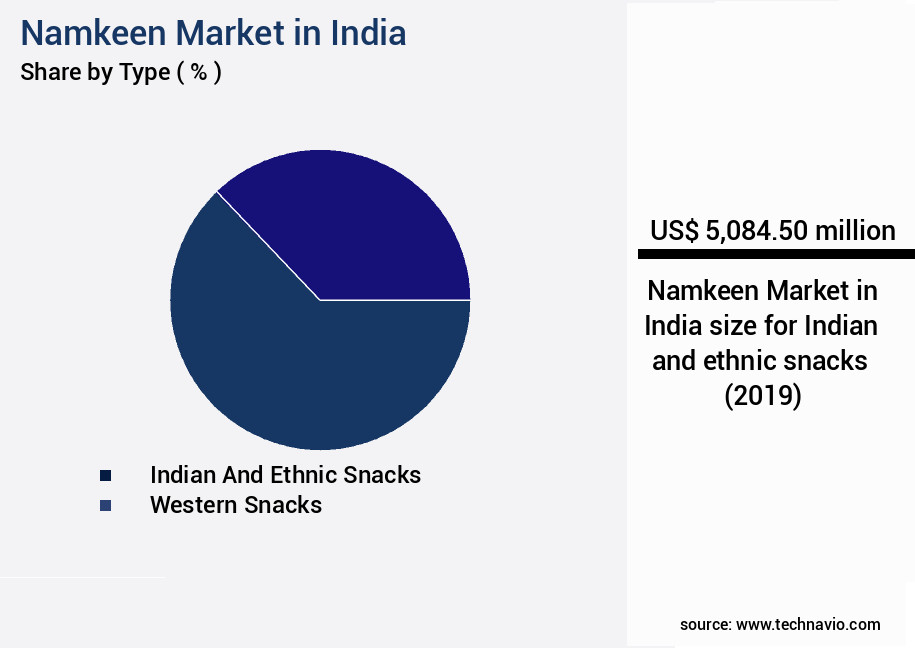
Request Free Sample
The Indian and ethnic snacks segment was valued at USD 5.08 billion in 2019 and showed a gradual increase during the forecast period.
In the dynamic Indian market, optimizing spice blend for enhanced flavor is essential to capture diverse taste preferences, while improving shelf life through modified atmosphere packaging ensures product freshness. Analyzing consumer preferences for texture in namkeen helps in crafting products that resonate with target segments. Simultaneously, developing sustainable packaging for namkeen products aligns with eco-conscious consumer demands. Implementing efficient supply chain management for namkeen supports faster delivery and reduced costs. Measuring consumer satisfaction with namkeen product attributes provides actionable insights for refinement. Reducing energy consumption in namkeen manufacturing and improving water usage efficiency in namkeen processing are vital for sustainable growth.
Analyzing ingredient cost to optimize namkeen profitability and implementing quality control measures for namkeen production further boost operational efficiency. Ensuring regulatory compliance for namkeen food safety builds consumer trust, while developing new product innovations for the namkeen market, strategic pricing models for different namkeen segments, and effective marketing campaigns for namkeen product launch are key to expanding reach. Optimizing distribution network for improved namkeen sales, effective retail display strategies for namkeen products, and analyzing consumer behavior towards different namkeen types enhance market visibility. Developing new product flavors for expanding namkeen reach, understanding consumer segmentation in the namkeen market, and efficient inventory management for namkeen distribution collectively drive long-term success.
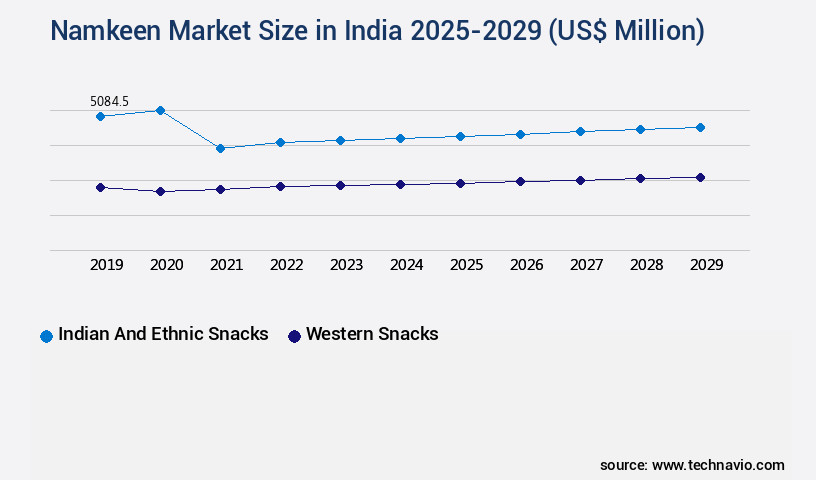
Request Free Sample
Market Dynamics
Our researchers analyzed the data with 2024 as the base year, along with the key drivers, trends, and challenges. A holistic analysis of drivers will help companies refine their marketing strategies to gain a competitive advantage.
The market, a significant contributor to the country's snack food industry, continues to evolve with various strategic initiatives aimed at optimizing product offerings, enhancing consumer experiences, and ensuring regulatory compliance. This dynamic market is witnessing numerous innovations in areas such as spice blends, packaging, and sustainability. To cater to evolving consumer preferences, manufacturers are meticulously analyzing texture and flavor trends in Namkeen, leading to the optimization of spice blends for enhanced flavor and improved shelf life through modified atmosphere packaging. Sustainability is another key focus area, with the development of eco-friendly packaging solutions for Namkeen products gaining traction.
Efficient supply chain management plays a crucial role in Namkeen production, with manufacturers implementing measures to reduce energy consumption and improve water usage efficiency. Cost optimization is also a priority, with ingredient cost analysis being a critical factor in Namkeen profitability. Quality control measures and regulatory compliance are essential for ensuring food safety and consumer satisfaction, which is being measured through various product attribute surveys. Innovation is a significant driver in the Namkeen market, with strategic pricing models and effective marketing campaigns being employed for different Namkeen segments. Effective retail display strategies and distribution network optimization are also crucial for improved sales.
Consumer behavior towards different Namkeen types is being analyzed to understand segmentation and expand market reach through new product developments and flavors. Compared to traditional methods, the adoption of advanced technologies in Namkeen manufacturing is leading to significant reductions in production time and resource utilization. For instance, automated production lines have resulted in a nearly 30% increase in output efficiency for some manufacturers. These advancements underscore the market's commitment to continuous improvement and growth.
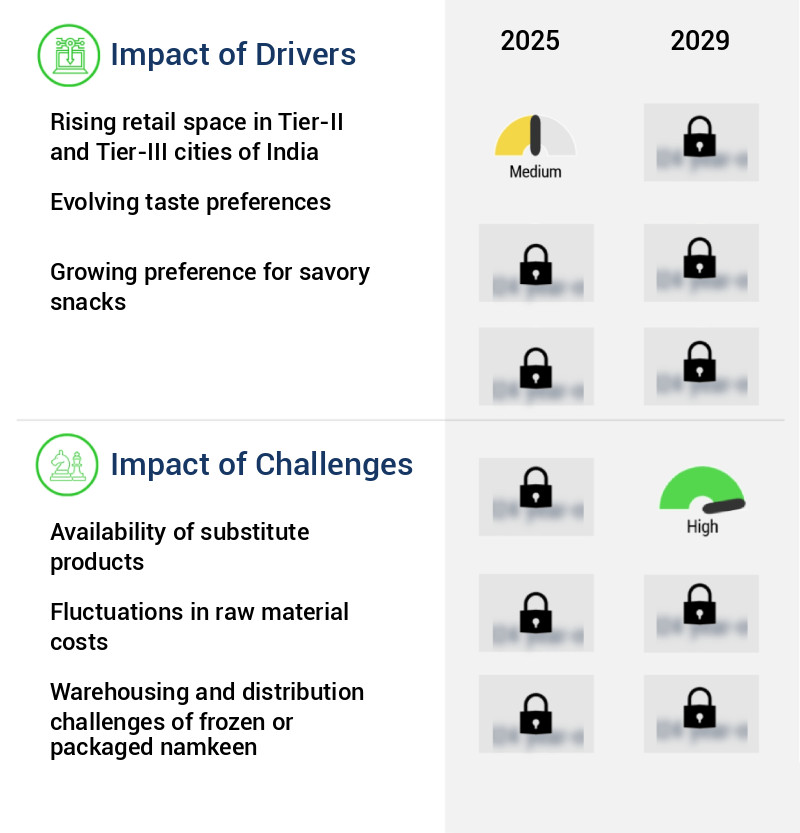
What are the key market drivers leading to the rise in the adoption of Namkeen in India Industry?
- The significant expansion of retail real estate in Tier-II and Tier-III cities of India serves as the primary market driver.
- Indian cities, including Jaipur, Udaipur, Imphal, Lucknow, and Patna, are witnessing a surge in retail consumption, particularly of traditional Indian snacks like namkeen. This trend is attributed to the rise in per capita income, leading established retailers such as Big Bazaar, Reliance Fresh, and D Mart to expand their presence in these cities. For instance, in 2024, BigBasket, owned by the Tata Group, introduced self-service outlets in Mumbai and Pune, equipped with advanced technology, including AI-driven self-checkout counters and video AI tools, to enhance the shopping experience.
- The expanding retail sector and growing purchasing power in India are expected to fuel the demand for namkeens during the forecast period.
What are the market trends shaping the Namkeen in India Industry?
- Online retailing is experiencing significant growth and is becoming the prevailing market trend.
- The market is experiencing an evolving nature, driven by the burgeoning e-commerce sector. With increasing Internet penetration, the convenience of online shopping has led to a surge in demand. This shift presents opportunities for namkeen suppliers to expand sales, broaden geographic reach, and enhance customer relationships and profitability. Online presence enables manufacturers and distributors to boost product visibility across regions.
- Companies can also explore new and growing markets with increased geographic coverage. The convenience of online buying has made it a preferred choice for consumers, leading several manufacturers and distributors to focus on online sales. This transition is essential for businesses aiming to stay competitive in the dynamic marketplace.
What challenges does the Namkeen in India Industry face during its growth?
- The growth of the industry is significantly impacted by the presence of viable substitutes in the market, which poses a significant challenge.
- The market is evolving, with fried and baked snacks emerging as viable alternatives. Companies are expanding their product lines by introducing new varieties and value-added ingredients. This trend is driving up demand for these substitutes, as health-conscious consumers increasingly prefer them over traditional namkeen. Baked snacks, for instance, offer several health benefits and are gaining popularity. The moderate switching costs associated with these substitutes are also encouraging consumers to make the shift.
- With the increasing popularity of baked snacks, they are poised to become significant competitors to namkeen in the snack market. This dynamic shift in consumer preferences underscores the evolving nature of the Indian snack industry.
Exclusive Customer Landscape
The India namkeen market forecasting report includes the adoption lifecycle of the market, covering from the innovator's stage to the laggard's stage. It focuses on adoption rates in different regions based on penetration. Furthermore, the India namkeen market report also includes key purchase criteria and drivers of price sensitivity to help companies evaluate and develop their market growth analysis strategies.
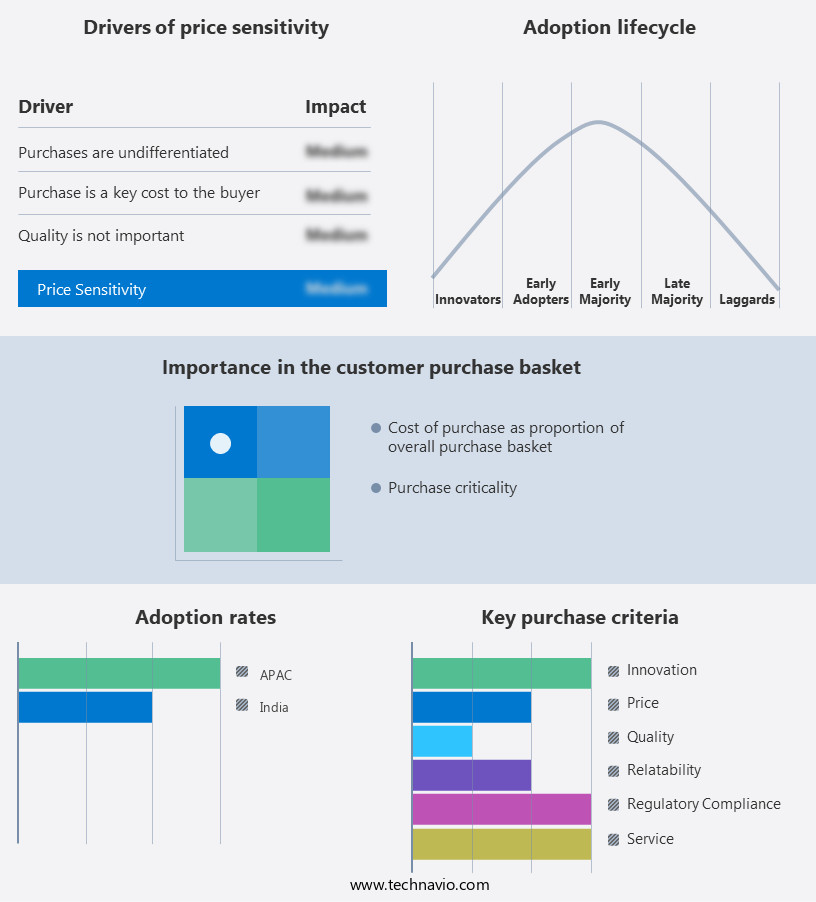
Customer Landscape of Namkeen in India Industry
Competitive Landscape & Market Insights
Companies are implementing various strategies, such as strategic alliances, India namkeen market forecast, partnerships, mergers and acquisitions, geographical expansion, and product/service launches, to enhance their presence in the industry.
Ashok Masale - The company specializing in the production and distribution of savory snacks, including aloo bhujia. Their product line caters to the global market, showcasing authentic Indian flavors and high-quality ingredients. The company's innovative approach to traditional recipes and commitment to consumer satisfaction sets it apart in the competitive snack industry.
The industry research and growth report includes detailed analyses of the competitive landscape of the market and information about key companies, including:
- Ashok Masale
- Babaji Snacks Pvt. Ltd.
- Balaji Wafers Pvt. Ltd.
- Bikaji Foods International Ltd.
- Bikanervala Foods Pvt. Ltd
- Bikharam Chandmal
- Desai Brothers Ltd.
- Gopal Snacks Pvt. Ltd
- Haldiram Foods International Pvt. Ltd.
- ITC Ltd.
- JABSONS COTTONSEED IND. PVT. LTD.
- Maa Laxmi Namkeen
- Maxvita Foods Pvt. Ltd.
- Parle Products Pvt. Ltd.
- Patanjali Ayurved Ltd.
- Prakash Namkeen Udyog
- Prataap Snacks Ltd.
- Priniti Foods Pvt Ltd
- Shri Ajab Foods Pvt Ltd.
- Sonal Foods
Qualitative and quantitative analysis of companies has been conducted to help clients understand the wider business environment as well as the strengths and weaknesses of key industry players. Data is qualitatively analyzed to categorize companies as pure play, category-focused, industry-focused, and diversified; it is quantitatively analyzed to categorize companies as dominant, leading, strong, tentative, and weak.
Recent Development and News in Namkeen Market In India
- In August 2024, Haldiram Foods International, a leading player in the market, announced the launch of its new product line, 'Bhujia Delight,' which includes six new variants of traditional Bhujia snacks. This expansion was revealed in a company press release and aims to cater to the growing demand for innovative and healthier snacking options (Haldiram Foods International Press Release, 2024).
- In November 2024, Patanjali Ayurved Limited, another major player, entered into a strategic partnership with a leading e-commerce platform, Amazon India, to sell its Namkeen products online. This collaboration was reported by Reuters and is expected to strengthen Patanjali's reach and distribution network (Reuters, 2024).
- In February 2025, Amul, the Indian dairy cooperative, acquired a 51% stake in Adani Wilmar's Namkeen business for INR 3,200 crores. This acquisition was disclosed in a filing by Adani Wilmar to the Bombay Stock Exchange and marks Amul's entry into the Namkeen market (Adani Wilmar Securities Filing, 2025).
- In May 2025, the Food Safety and Standards Authority of India (FSSAI) introduced new regulations for the labeling of Namkeen products, requiring manufacturers to declare the amount of trans-fat content on their packaging. This policy change was announced in an FSSAI press release and is aimed at promoting healthier food choices for consumers (FSSAI Press Release, 2025).
Dive into Technavio's robust research methodology, blending expert interviews, extensive data synthesis, and validated models for unparalleled India Namkeen Market insights. See full methodology.
|
Market Scope
|
|
Report Coverage
|
Details
|
|
Page number
|
182
|
|
Base year
|
2024
|
|
Historic period
|
2019-2023 |
|
Forecast period
|
2025-2029
|
|
Growth momentum & CAGR
|
Accelerate at a CAGR of 10.2%
|
|
Market growth 2025-2029
|
USD 4517.8 million
|
|
Market structure
|
Fragmented
|
|
YoY growth 2024-2025(%)
|
9.1
|
|
Key countries
|
India
|
|
Competitive landscape
|
Leading Companies, Market Positioning of Companies, Competitive Strategies, and Industry Risks
|
Request Free Sample
Research Analyst Overview
- The market continues to evolve, presenting dynamic opportunities for businesses. Packaging material selection plays a pivotal role in consumer preference, with sustainable options gaining traction. Pricing strategies are intricately linked to brand positioning, requiring careful analysis. Demand planning models help mitigate supply chain risks, while new product development fuels growth. Profit margin improvement through ingredient cost analysis and texture modification techniques is a constant focus. Water usage optimization and flavor compound profiles are essential for innovation and sustainability. Sensory evaluation methods ensure product quality and consumer satisfaction. Retail display strategies and consumer segmentation are crucial for effective marketing campaigns.
- Food safety regulations, production process efficiency, and product differentiation are key market share dynamics. Sustainable packaging, nutritional labeling requirements, and sales forecasting are essential for competitive advantage. Market share dynamics are influenced by product innovation, process automation technologies, and customer satisfaction metrics. Shelf life extension, waste reduction strategies, and inventory management are critical for operational efficiency. Energy consumption reduction and spice blend optimization are ongoing initiatives to reduce costs. Supply chain management and distribution network optimization are essential for business success. For instance, a leading namkeen manufacturer achieved a 15% sales increase by optimizing their production process and implementing a more efficient inventory management system.
- Industry growth is expected to reach 12% annually, driven by consumer demand and technological advancements.
What are the Key Data Covered in this India Namkeen Market Research and Growth Report?
-
What is the expected growth of the India Namkeen Market between 2025 and 2029?
-
What segmentation does the market report cover?
-
The report is segmented by Type (Indian and ethnic snacks and Western snacks), Distribution Channel (Offline and Online), Price Range (Economy, Mid-range, and Premium), Product Type (Pouches, Tins, and Others), and Geography (APAC)
-
Which regions are analyzed in the report?
-
What are the key growth drivers and market challenges?
-
Who are the major players in the Namkeen Market in India?
-
Ashok Masale, Babaji Snacks Pvt. Ltd., Balaji Wafers Pvt. Ltd., Bikaji Foods International Ltd., Bikanervala Foods Pvt. Ltd, Bikharam Chandmal, Desai Brothers Ltd., Gopal Snacks Pvt. Ltd, Haldiram Foods International Pvt. Ltd., ITC Ltd., JABSONS COTTONSEED IND. PVT. LTD., Maa Laxmi Namkeen, Maxvita Foods Pvt. Ltd., Parle Products Pvt. Ltd., Patanjali Ayurved Ltd., Prakash Namkeen Udyog, Prataap Snacks Ltd., Priniti Foods Pvt Ltd, Shri Ajab Foods Pvt Ltd., and Sonal Foods
Market Research Insights
- The market for namkeen, a popular category of Indian savory snacks, continues to evolve with ongoing consumer preferences and industry advancements. Approximately 15% of the Indian snack food market share is attributed to namkeen, with sales reaching over 2 billion units annually. This figure is expected to grow by 10% yearly due to increasing demand for convenient, affordable, and flavorful snacking options. For instance, the integration of advanced snack food processing techniques has led to cost reduction and improved product consistency. Sustainability initiatives, such as the use of eco-friendly packaging and organic ingredients, have also gained traction. Consumer behavior research indicates a growing preference for customized flavor profiles and sensory attributes, driving product development efforts.
- Additionally, retail channel management and demand forecasting strategies have become essential for maintaining inventory control and optimizing pricing models. Marketing research and brand building remain crucial components of the industry, with sales promotion and quality improvement playing significant roles in attracting and retaining customers. Companies are also focusing on process optimization, waste management, and food safety to enhance their competitive edge. The continuous evolution of the market reflects its dynamic and diverse nature, offering ample opportunities for growth and innovation.
We can help! Our analysts can customize this India namkeen market research report to meet your requirements.
Get in touch
1 Executive Summary
- 1.1 Market overview
- Executive Summary - Chart on Market Overview
- Executive Summary - Data Table on Market Overview
- Executive Summary - Chart on Country Market Characteristics
- Executive Summary - Chart on Market Segmentation by Type
- Executive Summary - Chart on Market Segmentation by Distribution Channel
- Executive Summary - Chart on Market Segmentation by Price Range
- Executive Summary - Chart on Market Segmentation by Product Type
- Executive Summary - Chart on Company Market Positioning
2 Technavio Analysis
- 2.1 Analysis of price sensitivity, lifecycle, customer purchase basket, adoption rates, and purchase criteria
- Analysis of price sensitivity, lifecycle, customer purchase basket, adoption rates, and purchase criteria
- 2.2 Criticality of inputs and Factors of differentiation
- Overview on criticality of inputs and factors of differentiation
- 2.3 Factors of disruption
- Overview on factors of disruption
- 2.4 Impact of drivers and challenges
- Impact of drivers and challenges in 2024 and 2029
3 Market Landscape
- 3.1 Market ecosystem
- Parent Market
- Data Table on - Parent Market
- 3.2 Market characteristics
- Market characteristics analysis
4 Market Sizing
- 4.1 Market definition
- Offerings of companies included in the market definition
- 4.2 Market segment analysis
- 4.4 Market outlook: Forecast for 2024-2029
- Chart on India - Market size and forecast 2024-2029 ($ million)
- Data Table on India - Market size and forecast 2024-2029 ($ million)
- Chart on India: Year-over-year growth 2024-2029 (%)
- Data Table on India: Year-over-year growth 2024-2029 (%)
5 Historic Market Size
- 5.1 Namkeen Market in India 2019 - 2023
- Historic Market Size - Data Table on Namkeen Market in India 2019 - 2023 ($ million)
- 5.2 Type segment analysis 2019 - 2023
- Historic Market Size - Type Segment 2019 - 2023 ($ million)
- 5.3 Distribution Channel segment analysis 2019 - 2023
- Historic Market Size - Distribution Channel Segment 2019 - 2023 ($ million)
- 5.4 Price Range segment analysis 2019 - 2023
- Historic Market Size - Price Range Segment 2019 - 2023 ($ million)
- 5.5 Product Type segment analysis 2019 - 2023
- Historic Market Size - Product Type Segment 2019 - 2023 ($ million)
6 Qualitative Analysis
- 6.1 Impact of AI in the namkeen market in India
7 Five Forces Analysis
- 7.1 Five forces summary
- Five forces analysis - Comparison between 2024 and 2029
- 7.2 Bargaining power of buyers
- Bargaining power of buyers - Impact of key factors 2024 and 2029
- 7.3 Bargaining power of suppliers
- Bargaining power of suppliers - Impact of key factors in 2024 and 2029
- 7.4 Threat of new entrants
- Threat of new entrants - Impact of key factors in 2024 and 2029
- 7.5 Threat of substitutes
- Threat of substitutes - Impact of key factors in 2024 and 2029
- 7.6 Threat of rivalry
- Threat of rivalry - Impact of key factors in 2024 and 2029
- 7.7 Market condition
- Chart on Market condition - Five forces 2024 and 2029
8 Market Segmentation by Type
- 8.1 Market segments
- Chart on Type - Market share 2024-2029 (%)
- Data Table on Type - Market share 2024-2029 (%)
- 8.2 Comparison by Type
- Chart on Comparison by Type
- Data Table on Comparison by Type
- 8.3 Indian and ethnic snacks - Market size and forecast 2024-2029
- Chart on Indian and ethnic snacks - Market size and forecast 2024-2029 ($ million)
- Data Table on Indian and ethnic snacks - Market size and forecast 2024-2029 ($ million)
- Chart on Indian and ethnic snacks - Year-over-year growth 2024-2029 (%)
- Data Table on Indian and ethnic snacks - Year-over-year growth 2024-2029 (%)
- 8.4 Western snacks - Market size and forecast 2024-2029
- Chart on Western snacks - Market size and forecast 2024-2029 ($ million)
- Data Table on Western snacks - Market size and forecast 2024-2029 ($ million)
- Chart on Western snacks - Year-over-year growth 2024-2029 (%)
- Data Table on Western snacks - Year-over-year growth 2024-2029 (%)
- 8.5 Market opportunity by Type
- Market opportunity by Type ($ million)
- Data Table on Market opportunity by Type ($ million)
9 Market Segmentation by Distribution Channel
- 9.1 Market segments
- Chart on Distribution Channel - Market share 2024-2029 (%)
- Data Table on Distribution Channel - Market share 2024-2029 (%)
- 9.2 Comparison by Distribution Channel
- Chart on Comparison by Distribution Channel
- Data Table on Comparison by Distribution Channel
- 9.3 Offline - Market size and forecast 2024-2029
- Chart on Offline - Market size and forecast 2024-2029 ($ million)
- Data Table on Offline - Market size and forecast 2024-2029 ($ million)
- Chart on Offline - Year-over-year growth 2024-2029 (%)
- Data Table on Offline - Year-over-year growth 2024-2029 (%)
- 9.4 Online - Market size and forecast 2024-2029
- Chart on Online - Market size and forecast 2024-2029 ($ million)
- Data Table on Online - Market size and forecast 2024-2029 ($ million)
- Chart on Online - Year-over-year growth 2024-2029 (%)
- Data Table on Online - Year-over-year growth 2024-2029 (%)
- 9.5 Market opportunity by Distribution Channel
- Market opportunity by Distribution Channel ($ million)
- Data Table on Market opportunity by Distribution Channel ($ million)
10 Market Segmentation by Price Range
- 10.1 Market segments
- Chart on Price Range - Market share 2024-2029 (%)
- Data Table on Price Range - Market share 2024-2029 (%)
- 10.2 Comparison by Price Range
- Chart on Comparison by Price Range
- Data Table on Comparison by Price Range
- 10.3 Economy - Market size and forecast 2024-2029
- Chart on Economy - Market size and forecast 2024-2029 ($ million)
- Data Table on Economy - Market size and forecast 2024-2029 ($ million)
- Chart on Economy - Year-over-year growth 2024-2029 (%)
- Data Table on Economy - Year-over-year growth 2024-2029 (%)
- 10.4 Mid-range - Market size and forecast 2024-2029
- Chart on Mid-range - Market size and forecast 2024-2029 ($ million)
- Data Table on Mid-range - Market size and forecast 2024-2029 ($ million)
- Chart on Mid-range - Year-over-year growth 2024-2029 (%)
- Data Table on Mid-range - Year-over-year growth 2024-2029 (%)
- 10.5 Premium - Market size and forecast 2024-2029
- Chart on Premium - Market size and forecast 2024-2029 ($ million)
- Data Table on Premium - Market size and forecast 2024-2029 ($ million)
- Chart on Premium - Year-over-year growth 2024-2029 (%)
- Data Table on Premium - Year-over-year growth 2024-2029 (%)
- 10.6 Market opportunity by Price Range
- Market opportunity by Price Range ($ million)
- Data Table on Market opportunity by Price Range ($ million)
11 Market Segmentation by Product Type
- 11.1 Market segments
- Chart on Product Type - Market share 2024-2029 (%)
- Data Table on Product Type - Market share 2024-2029 (%)
- 11.2 Comparison by Product Type
- Chart on Comparison by Product Type
- Data Table on Comparison by Product Type
- 11.3 Pouches - Market size and forecast 2024-2029
- Chart on Pouches - Market size and forecast 2024-2029 ($ million)
- Data Table on Pouches - Market size and forecast 2024-2029 ($ million)
- Chart on Pouches - Year-over-year growth 2024-2029 (%)
- Data Table on Pouches - Year-over-year growth 2024-2029 (%)
- 11.4 Tins - Market size and forecast 2024-2029
- Chart on Tins - Market size and forecast 2024-2029 ($ million)
- Data Table on Tins - Market size and forecast 2024-2029 ($ million)
- Chart on Tins - Year-over-year growth 2024-2029 (%)
- Data Table on Tins - Year-over-year growth 2024-2029 (%)
- 11.5 Others - Market size and forecast 2024-2029
- Chart on Others - Market size and forecast 2024-2029 ($ million)
- Data Table on Others - Market size and forecast 2024-2029 ($ million)
- Chart on Others - Year-over-year growth 2024-2029 (%)
- Data Table on Others - Year-over-year growth 2024-2029 (%)
- 11.6 Market opportunity by Product Type
- Market opportunity by Product Type ($ million)
- Data Table on Market opportunity by Product Type ($ million)
12 Customer Landscape
- 12.1 Customer landscape overview
- Analysis of price sensitivity, lifecycle, customer purchase basket, adoption rates, and purchase criteria
13 Drivers, Challenges, and Opportunity/Restraints
- 13.3 Impact of drivers and challenges
- Impact of drivers and challenges in 2024 and 2029
- 13.4 Market opportunities/restraints
14 Competitive Landscape
- 14.2 Competitive Landscape
- Overview on criticality of inputs and factors of differentiation
- 14.3 Landscape disruption
- Overview on factors of disruption
- 14.4 Industry risks
- Impact of key risks on business
15 Competitive Analysis
- 15.2 Company ranking index
- 15.3 Market positioning of companies
- Matrix on companies position and classification
- 15.4 Babaji Snacks Pvt. Ltd.
- Babaji Snacks Pvt. Ltd. - Overview
- Babaji Snacks Pvt. Ltd. - Product / Service
- Babaji Snacks Pvt. Ltd. - Key offerings
- SWOT
- 15.5 Balaji Wafers Pvt. Ltd.
- Balaji Wafers Pvt. Ltd. - Overview
- Balaji Wafers Pvt. Ltd. - Product / Service
- Balaji Wafers Pvt. Ltd. - Key offerings
- SWOT
- 15.6 Bikaji Foods International Ltd.
- Bikaji Foods International Ltd. - Overview
- Bikaji Foods International Ltd. - Product / Service
- Bikaji Foods International Ltd. - Key offerings
- SWOT
- 15.7 Bikanervala Foods Pvt. Ltd
- Bikanervala Foods Pvt. Ltd - Overview
- Bikanervala Foods Pvt. Ltd - Product / Service
- Bikanervala Foods Pvt. Ltd - Key offerings
- SWOT
- 15.8 Gopal Snacks Pvt. Ltd
- Gopal Snacks Pvt. Ltd - Overview
- Gopal Snacks Pvt. Ltd - Product / Service
- Gopal Snacks Pvt. Ltd - Key offerings
- SWOT
- 15.9 Haldiram Foods International Pvt. Ltd.
- Haldiram Foods International Pvt. Ltd. - Overview
- Haldiram Foods International Pvt. Ltd. - Product / Service
- Haldiram Foods International Pvt. Ltd. - Key offerings
- SWOT
- 15.10 ITC Ltd.
- ITC Ltd. - Overview
- ITC Ltd. - Business segments
- ITC Ltd. - Key news
- ITC Ltd. - Key offerings
- ITC Ltd. - Segment focus
- SWOT
- 15.11 JABSONS COTTONSEED IND. PVT. LTD.
- JABSONS COTTONSEED IND. PVT. LTD. - Overview
- JABSONS COTTONSEED IND. PVT. LTD. - Product / Service
- JABSONS COTTONSEED IND. PVT. LTD. - Key offerings
- SWOT
- 15.12 Maxvita Foods Pvt. Ltd.
- Maxvita Foods Pvt. Ltd. - Overview
- Maxvita Foods Pvt. Ltd. - Product / Service
- Maxvita Foods Pvt. Ltd. - Key offerings
- SWOT
- 15.13 Parle Products Pvt. Ltd.
- Parle Products Pvt. Ltd. - Overview
- Parle Products Pvt. Ltd. - Product / Service
- Parle Products Pvt. Ltd. - Key offerings
- SWOT
- 15.14 Patanjali Ayurved Ltd.
- Patanjali Ayurved Ltd. - Overview
- Patanjali Ayurved Ltd. - Product / Service
- Patanjali Ayurved Ltd. - Key offerings
- SWOT
- 15.15 Prakash Namkeen Udyog
- Prakash Namkeen Udyog - Overview
- Prakash Namkeen Udyog - Product / Service
- Prakash Namkeen Udyog - Key offerings
- SWOT
- 15.16 Prataap Snacks Ltd.
- Prataap Snacks Ltd. - Overview
- Prataap Snacks Ltd. - Product / Service
- Prataap Snacks Ltd. - Key offerings
- SWOT
- 15.17 Priniti Foods Pvt Ltd
- Priniti Foods Pvt Ltd - Overview
- Priniti Foods Pvt Ltd - Product / Service
- Priniti Foods Pvt Ltd - Key offerings
- SWOT
- 15.18 Sonal Foods
- Sonal Foods - Overview
- Sonal Foods - Product / Service
- Sonal Foods - Key offerings
- SWOT
16 Appendix
- 16.2 Inclusions and exclusions checklist
- Inclusions checklist
- Exclusions checklist
- 16.3 Currency conversion rates for US$
- Currency conversion rates for US$
- 16.4 Research methodology
- 16.7 Validation techniques employed for market sizing
- Validation techniques employed for market sizing
- 16.9 360 degree market analysis
- 360 degree market analysis
- 16.10 List of abbreviations







![]() Get the report (PDF) sent to your email within minutes.
Get the report (PDF) sent to your email within minutes.
Complimentary full Excel data with your report purchase.